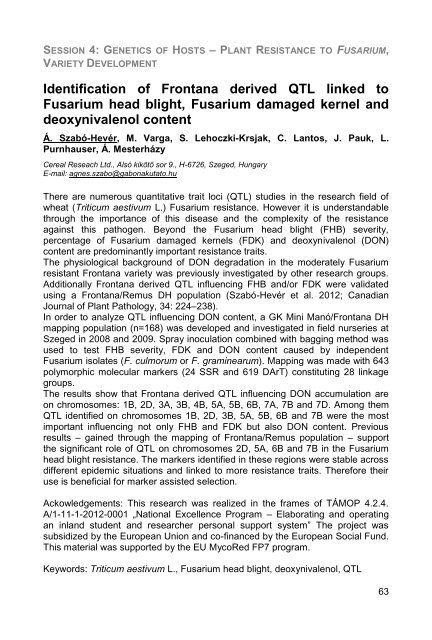EFS12- Book of abstracts - Contact
EFS12- Book of abstracts - Contact
EFS12- Book of abstracts - Contact
You also want an ePaper? Increase the reach of your titles
YUMPU automatically turns print PDFs into web optimized ePapers that Google loves.
SESSION 4: GENETICS OF HOSTS – PLANT RESISTANCE TO FUSARIUM,<br />
VARIETY DEVELOPMENT<br />
Identification <strong>of</strong> Frontana derived QTL linked to<br />
Fusarium head blight, Fusarium damaged kernel and<br />
deoxynivalenol content<br />
Á. Szabó-Hevér, M. Varga, S. Lehoczki-Krsjak, C. Lantos, J. Pauk, L.<br />
Purnhauser, Á. Mesterházy<br />
Cereal Reseach Ltd., Alsó kikötő sor 9., H-6726, Szeged, Hungary<br />
E-mail: agnes.szabo@gabonakutato.hu<br />
There are numerous quantitative trait loci (QTL) studies in the research field <strong>of</strong><br />
wheat (Triticum aestivum L.) Fusarium resistance. However it is understandable<br />
through the importance <strong>of</strong> this disease and the complexity <strong>of</strong> the resistance<br />
against this pathogen. Beyond the Fusarium head blight (FHB) severity,<br />
percentage <strong>of</strong> Fusarium damaged kernels (FDK) and deoxynivalenol (DON)<br />
content are predominantly important resistance traits.<br />
The physiological background <strong>of</strong> DON degradation in the moderately Fusarium<br />
resistant Frontana variety was previously investigated by other research groups.<br />
Additionally Frontana derived QTL influencing FHB and/or FDK were validated<br />
using a Frontana/Remus DH population (Szabó-Hevér et al. 2012; Canadian<br />
Journal <strong>of</strong> Plant Pathology, 34: 224–238).<br />
In order to analyze QTL influencing DON content, a GK Mini Manó/Frontana DH<br />
mapping population (n=168) was developed and investigated in field nurseries at<br />
Szeged in 2008 and 2009. Spray inoculation combined with bagging method was<br />
used to test FHB severity, FDK and DON content caused by independent<br />
Fusarium isolates (F. culmorum or F. graminearum). Mapping was made with 643<br />
polymorphic molecular markers (24 SSR and 619 DArT) constituting 28 linkage<br />
groups.<br />
The results show that Frontana derived QTL influencing DON accumulation are<br />
on chromosomes: 1B, 2D, 3A, 3B, 4B, 5A, 5B, 6B, 7A, 7B and 7D. Among them<br />
QTL identified on chromosomes 1B, 2D, 3B, 5A, 5B, 6B and 7B were the most<br />
important influencing not only FHB and FDK but also DON content. Previous<br />
results – gained through the mapping <strong>of</strong> Frontana/Remus population – support<br />
the significant role <strong>of</strong> QTL on chromosomes 2D, 5A, 6B and 7B in the Fusarium<br />
head blight resistance. The markers identified in these regions were stable across<br />
different epidemic situations and linked to more resistance traits. Therefore their<br />
use is beneficial for marker assisted selection.<br />
Ackowledgements: This research was realized in the frames <strong>of</strong> TÁMOP 4.2.4.<br />
A/1-11-1-2012-0001 „National Excellence Program – Elaborating and operating<br />
an inland student and researcher personal support system” The project was<br />
subsidized by the European Union and co-financed by the European Social Fund.<br />
This material was supported by the EU MycoRed FP7 program.<br />
Keywords: Triticum aestivum L., Fusarium head blight, deoxynivalenol, QTL<br />
63
















![Présentation CRB-anim [Mode de compatibilité] - Inra](https://img.yumpu.com/17418636/1/190x135/presentation-crb-anim-mode-de-compatibilite-inra.jpg?quality=85)